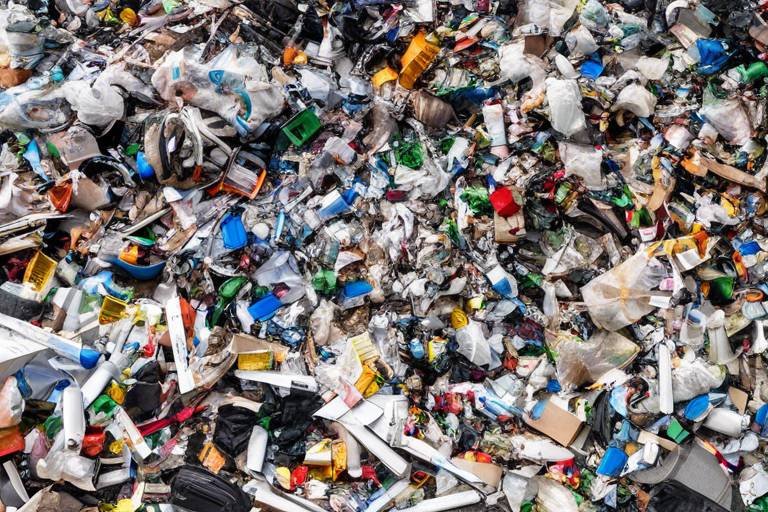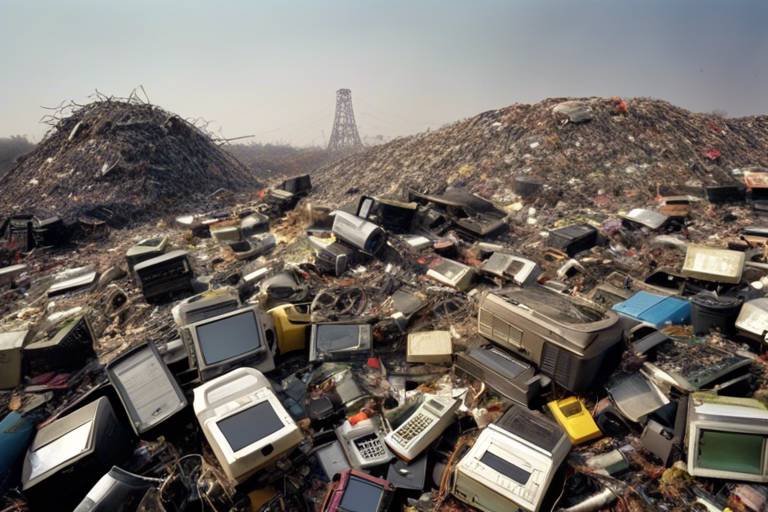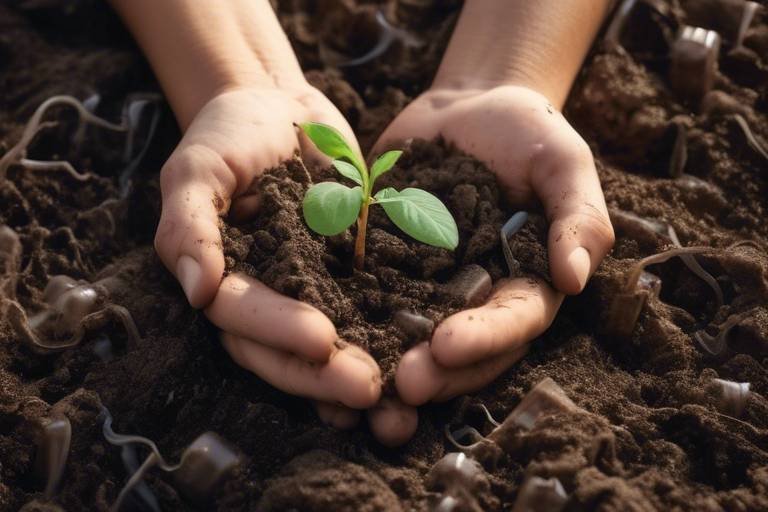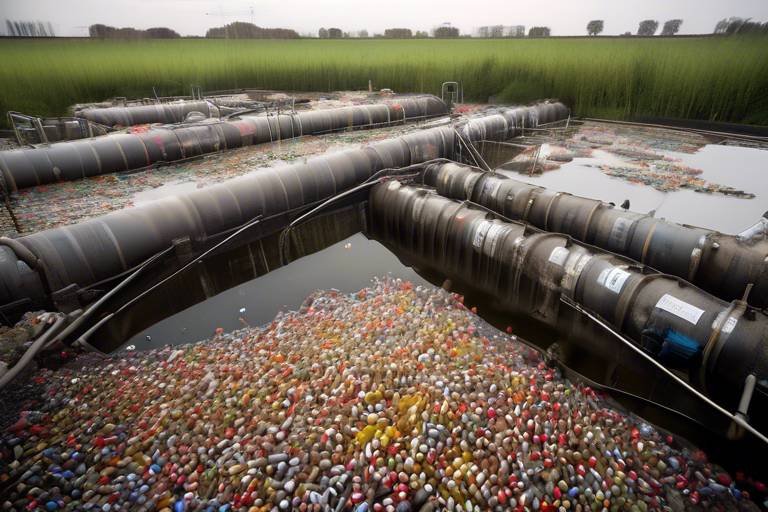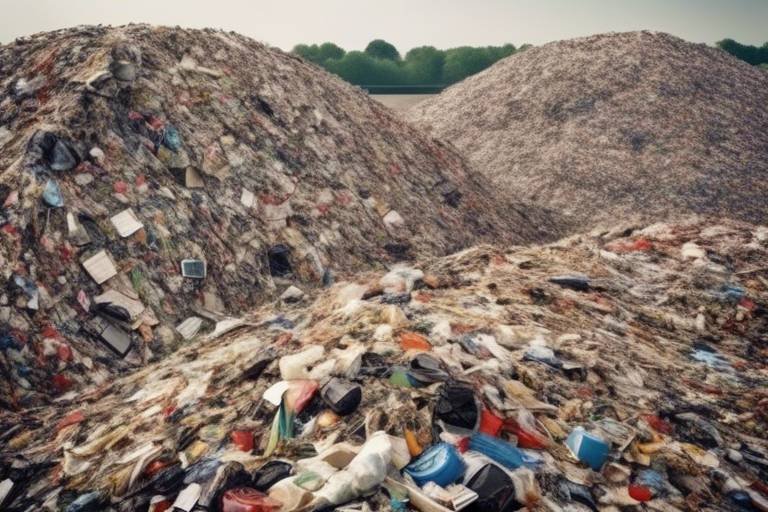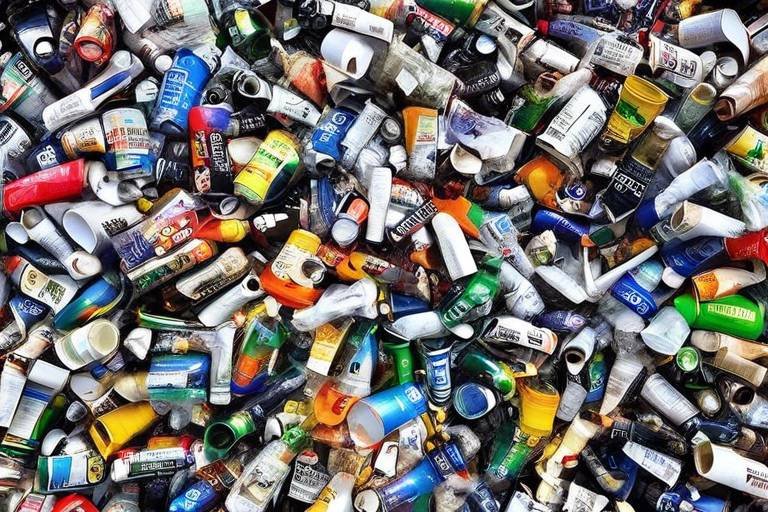The Real Story Behind Your Paper Waste
Have you ever stopped to think about where your paper comes from and where it goes after you’re done with it? It’s a journey filled with twists and turns, and it has a profound impact on our planet. Paper waste is not just a minor inconvenience; it's a significant environmental issue that affects our forests, wildlife, and even our climate. In this article, we’ll unravel the origins of paper, the impacts of its waste, and the solutions we can adopt to mitigate its effects. So, grab a cup of coffee, sit back, and let’s dive into the real story behind your paper waste!
The journey of paper begins with trees, but it doesn’t end there. Understanding the lifecycle of paper can shine a light on the environmental impacts at each stage. From the moment a tree is cut down to the time you toss that piece of paper into the trash, each step has its own set of consequences. When trees are harvested for paper, they are often replaced with monoculture plantations that lack biodiversity. This not only affects the animals that rely on diverse ecosystems but also leads to soil degradation and increased carbon emissions. It’s essential to consider how our consumption habits contribute to this cycle. By choosing sustainable practices, we can help minimize the negative impacts of paper production and consumption.
When we think about waste, paper is often overlooked. Yet, it contributes significantly to landfill issues and greenhouse gas emissions. Did you know that paper waste accounts for nearly 25% of landfill volume? When paper decomposes in landfills, it generates methane, a greenhouse gas that is over 25 times more potent than carbon dioxide over a 100-year period. This is a wake-up call for all of us to rethink our paper usage and disposal methods. We need to adopt responsible practices that can help reduce this environmental burden.
The demand for paper has a direct link to deforestation, which is a major threat to biodiversity. Every year, millions of acres of forests are cleared to meet the needs of the paper industry. This not only leads to habitat loss for countless species but also disrupts entire ecosystems. Imagine a world where the vibrant sounds of chirping birds and rustling leaves are replaced by silence. That’s the future we face if we continue on this path. It’s crucial to understand the direct effects of paper production on our forests and wildlife, as they are the backbone of our planet’s health.
Deforestation for paper production doesn’t just threaten wildlife; it also contributes to climate change. Trees play a vital role in absorbing carbon dioxide, and when they are cut down, this carbon is released back into the atmosphere, exacerbating global warming. By reducing our paper waste, we can help mitigate these carbon emissions. It’s like taking a step towards a healthier planet, where the air is cleaner, and the climate is more stable. Every small effort counts, and together, we can make a significant difference.
Fortunately, there is a silver lining! Sustainable forestry practices can help balance paper production with environmental conservation. These practices include selective logging, reforestation, and maintaining biodiversity in forest ecosystems. By supporting companies that prioritize sustainability, we can ensure that our paper products are sourced responsibly. So next time you purchase paper, look for certifications like FSC (Forest Stewardship Council) or SFI (Sustainable Forestry Initiative). Making informed choices can lead us towards a more sustainable future.
One of the most effective ways to combat paper waste is through recycling. Recycling paper not only saves trees but also conserves energy and reduces landfill use. In fact, recycling one ton of paper can save up to 17 trees, 7,000 gallons of water, and 4,100 kilowatts of electricity! Imagine the impact we could have if everyone made an effort to recycle their paper. It’s a simple yet powerful action that promotes a circular economy, where resources are reused and waste is minimized.
As we move forward, innovation plays a crucial role in reducing paper waste. From digital alternatives to eco-friendly materials, there are numerous strategies being developed to help us minimize our paper footprint. Embracing technology can empower us to make smarter choices that benefit both our lives and the environment.
The shift to digital documentation is one of the most significant changes in recent years, and it has the potential to drastically reduce paper use. Going paperless not only saves trees but also streamlines processes, making our lives easier. Imagine having all your documents at your fingertips without the clutter of physical paper. Tools like cloud storage, digital signatures, and online collaboration platforms are just a few of the resources available to facilitate this transition. It’s time to embrace the digital age and leave behind the old ways of paper dependency!
Exploring sustainable materials that can replace traditional paper is another exciting avenue. Innovations in materials such as bamboo, hemp, and recycled products showcase their potential in reducing paper waste. For instance, bamboo grows rapidly and can be harvested without killing the plant, making it a fantastic alternative. By choosing eco-friendly options, we can reduce our reliance on conventional paper and contribute to a healthier planet.
- What is the biggest contributor to paper waste? The largest contributor to paper waste is consumer habits, particularly excessive printing and single-use papers.
- Can all types of paper be recycled? Most paper can be recycled, but items like greasy pizza boxes or paper towels are not recyclable.
- How can I reduce my paper usage at home? You can reduce paper usage by going digital, using both sides of the paper, and opting for electronic bills and statements.

The Lifecycle of Paper
Understanding the lifecycle of paper is crucial for grasping its environmental impact. The journey of paper begins with the humble tree, which serves as the primary raw material. Once harvested, the wood undergoes a series of processes to transform it into the paper products we use daily. This journey is not just a simple transformation; it involves various stages that each leave a mark on our planet.
Initially, trees are cut down in a process that can lead to significant ecological disruption. Forests are not merely collections of trees; they are vibrant ecosystems that house countless species. The removal of these trees can lead to deforestation, which disrupts habitats and threatens biodiversity. As we delve deeper into the lifecycle, it’s essential to recognize that every sheet of paper starts as a living organism, and its production has far-reaching consequences.
After harvesting, the wood is transported to mills where it is processed into pulp. This process involves cooking the wood chips with chemicals to separate the fibers. While this is a necessary step for creating paper, it also generates waste and uses considerable amounts of water and energy. The environmental costs of this phase cannot be overlooked, as it contributes to pollution in nearby water bodies and increases the carbon footprint of paper production.
Once the pulp is ready, it is transformed into sheets of paper through a series of steps that include pressing and drying. This stage is where the paper takes its final form, but it’s also where the energy consumption peaks. The use of fossil fuels during this phase adds to the greenhouse gas emissions associated with paper production.
Finally, the paper reaches consumers, entering homes, schools, and businesses. However, the lifecycle doesn’t end here. After its use, paper can either be discarded or recycled. Unfortunately, a significant amount of paper ends up in landfills, where it decomposes and releases methane, a potent greenhouse gas. This highlights the importance of understanding not just the production side but also the disposal methods that can mitigate environmental impacts.
To summarize, the lifecycle of paper can be outlined as follows:
| Stage | Description | Environmental Impact |
|---|---|---|
| Harvesting | Cutting down trees for wood | Deforestation, habitat loss |
| Pulping | Transforming wood into pulp | Water pollution, energy consumption |
| Manufacturing | Producing paper sheets | High energy use, emissions |
| Consumption | Use of paper products | Waste generation |
| Disposal | Landfill or recycling | Methane emissions, resource recovery |
In conclusion, every piece of paper we use has a story that begins long before it reaches our hands and continues long after it’s discarded. By understanding this lifecycle, we can make more informed choices about our paper consumption and advocate for sustainable practices that minimize our environmental footprint.
- What is the main environmental impact of paper production? The main impacts include deforestation, water pollution, and greenhouse gas emissions.
- How can I reduce my paper waste? You can reduce paper waste by going digital, recycling, and using both sides of the paper.
- Are there sustainable alternatives to traditional paper? Yes, materials like bamboo, hemp, and recycled paper are eco-friendly alternatives.

Environmental Impact of Paper Waste
When we think about paper, we often picture our favorite books, beautiful stationery, or even the essential documents we rely on daily. However, what many don't realize is the hidden environmental impact that comes with our paper consumption. The journey from tree to paper product isn't just a simple one; it involves a complex lifecycle that leaves a significant mark on our planet. Every year, millions of tons of paper are produced, and with that comes a staggering amount of waste. This waste contributes to various ecological issues, including landfill overflow and greenhouse gas emissions.
To put things into perspective, let’s consider this: paper waste is the third largest component of municipal solid waste in landfills. When paper decomposes, it generates methane—a greenhouse gas that is over 25 times more potent than carbon dioxide over a 100-year period. Isn’t it alarming to think that our casual use of paper can lead to such severe environmental consequences? As we continue to consume paper at alarming rates, the need for responsible disposal and consumption practices has never been more crucial.
Moreover, the environmental impact of paper waste doesn’t just stop at landfills. The entire lifecycle of paper—from harvesting trees to manufacturing and finally disposal—has a ripple effect on our ecosystems. The production process consumes vast amounts of water and energy, leading to resource depletion. For instance, it takes about 24,000 gallons of water to produce a ton of paper. That’s enough water to fill a small swimming pool! And let’s not forget about the chemicals used in the bleaching and processing of paper, which can pollute our waterways and harm aquatic life.
In light of these facts, it’s essential to understand the broader implications of our paper habits. Here are some key points to consider:
- Deforestation: The demand for paper is a leading cause of deforestation, which not only threatens wildlife habitats but also reduces the number of trees that can absorb carbon dioxide.
- Loss of Biodiversity: As forests are cleared for paper production, countless species lose their homes, leading to a decline in biodiversity.
- Climate Change: The carbon emissions from paper production and waste contribute significantly to climate change, affecting weather patterns and global temperatures.
As we become more aware of these issues, it’s clear that reducing paper waste is not just a personal choice; it’s a global necessity. By adopting more sustainable practices and considering alternatives, we can make a positive impact on our environment. It's time to rethink our relationship with paper and take action to minimize our footprint.
- What can I do to reduce paper waste? You can start by going paperless with your bills and documents, using digital tools, and recycling any paper products you do use.
- How much paper is recycled? According to the EPA, about 66% of paper consumed in the U.S. is recycled, which is a significant improvement, but there’s still room for growth.
- Are there eco-friendly alternatives to paper? Yes! Materials like bamboo and hemp can serve as sustainable alternatives to traditional paper products.

Deforestation and Habitat Loss
Deforestation is one of the most pressing environmental issues of our time, and its connection to paper production is both profound and alarming. Every year, millions of trees are cut down to meet the ever-increasing demand for paper products. This relentless pursuit of paper not only strips away our forests but also leads to significant habitat loss for countless species. Imagine a vibrant forest, teeming with life, suddenly silenced as trees fall one by one; this is the reality of deforestation.
The effects of habitat loss are devastating. Species that depend on forest ecosystems for survival find themselves without homes, leading to declines in biodiversity. For instance, iconic animals such as the orangutan and the snow leopard are losing their habitats due to logging practices associated with paper production. The intricate web of life that thrives in these forests is disrupted, resulting in a cascading effect on the entire ecosystem. When we lose trees, we lose not only the animals that inhabit them but also the plants, fungi, and microorganisms that contribute to a balanced environment.
Moreover, the impact of deforestation extends beyond the immediate loss of wildlife. It disrupts water cycles, increases soil erosion, and contributes to climate change. Trees play a crucial role in absorbing carbon dioxide, and when they are removed, the stored carbon is released back into the atmosphere, exacerbating global warming. To illustrate this impact, consider the following table that outlines the consequences of deforestation:
| Consequences of Deforestation | Description |
|---|---|
| Loss of Biodiversity | Destruction of habitats leads to the extinction of species. |
| Climate Change | Increased carbon emissions contribute to global warming. |
| Soil Erosion | Without trees, soil becomes loose and is washed away, leading to land degradation. |
| Water Cycle Disruption | Forests regulate rainfall and water supplies; their loss can lead to droughts. |
Ultimately, the connection between paper production and deforestation is a critical issue that requires our attention. By understanding the profound impact of our paper consumption habits, we can make informed choices that promote sustainability. Each time we choose recycled paper or support sustainable forestry practices, we are taking a step towards preserving our forests and the diverse life they support. So, the next time you reach for a piece of paper, think about the journey it took to get there and the potential consequences of its production.
- What is the main cause of deforestation? Deforestation is primarily caused by agricultural expansion, logging, and infrastructure development.
- How does paper production contribute to habitat loss? The demand for paper leads to the clearing of forests, which displaces wildlife and destroys ecosystems.
- What can I do to help reduce paper waste? You can reduce paper waste by using digital alternatives, recycling paper, and choosing products made from sustainable materials.

Impact on Climate Change
When we think about climate change, we often picture industrial smokestacks or cars belching exhaust fumes. However, the role of paper production in this global crisis is often overlooked. Believe it or not, the paper industry is a significant contributor to greenhouse gas emissions, primarily due to the deforestation it causes. Trees are essential in absorbing carbon dioxide, one of the primary culprits of climate change. When forests are cleared to make way for paper products, not only is that carbon-absorbing capacity lost, but the carbon stored in the trees is released back into the atmosphere, exacerbating the problem.
The statistics are alarming. According to the Environmental Paper Network, the paper industry is responsible for about 15% of global greenhouse gas emissions. This figure is staggering when you consider the scale of paper consumption worldwide. Every time we choose to use paper, we are contributing to a cycle that harms our planet. It's a bit like adding more fuel to a fire that's already raging out of control.
Moreover, the process of turning trees into paper is energy-intensive. It involves various stages, including logging, pulping, and manufacturing, all of which require substantial amounts of energy, often derived from fossil fuels. This not only increases carbon emissions but also leads to other environmental issues such as water pollution and habitat destruction. The more paper we consume, the more we contribute to this vicious cycle of environmental degradation.
But there’s hope! By reducing paper waste, we can significantly lower our carbon footprint. Here are some impactful strategies:
- Embrace Digital Solutions: Transitioning to digital documentation can drastically cut down on paper use.
- Practice Responsible Consumption: Being mindful of how much paper we use in our daily lives can lead to substantial reductions.
- Support Sustainable Brands: Choose products from companies that prioritize sustainable practices in their paper production.
In summary, the impact of paper production on climate change is profound and multifaceted. By understanding this relationship, we can make informed choices that not only reduce our paper waste but also contribute to a healthier planet. It’s a small step that can lead to significant change, and every little bit counts. So next time you reach for that piece of paper, consider the broader implications of your choice. Together, we can turn the tide on climate change, one sheet at a time.
Q: How does paper production contribute to climate change?
A: Paper production contributes to climate change primarily through deforestation, which releases stored carbon dioxide into the atmosphere, along with the energy-intensive processes involved in manufacturing paper.
Q: What can I do to reduce my paper consumption?
A: You can reduce paper consumption by going digital, being mindful of how much paper you use, and supporting brands that practice sustainable forestry.
Q: Are there eco-friendly alternatives to traditional paper?
A: Yes! Materials like bamboo, hemp, and recycled products serve as excellent eco-friendly alternatives to traditional paper.

Sustainable Forestry Practices
When we talk about , we’re diving into a world where the balance between our paper needs and the environment is not just a dream but a reality. Imagine a forest where trees are harvested in a way that allows them to grow back, ensuring that future generations can enjoy the same lush landscapes we do today. This is the essence of sustainability in forestry: it’s about responsibility, conservation, and long-term thinking.
One of the key principles of sustainable forestry is the concept of selective logging. Instead of clear-cutting vast areas of forest, which can lead to devastating ecological consequences, selective logging involves carefully choosing which trees to cut down. This method not only minimizes the impact on the surrounding ecosystem but also promotes the growth of remaining trees, allowing for a healthier forest overall. Imagine it as pruning a plant—removing certain parts can lead to a more vibrant and thriving whole.
Another essential practice is the implementation of reforestation and afforestation. Reforestation refers to planting trees in areas that have been depleted, while afforestation involves creating new forests in previously non-forested areas. Both practices are crucial for restoring habitats, improving air quality, and sequestering carbon dioxide from the atmosphere. It's like giving Mother Nature a much-needed boost, helping her regain her strength and vitality.
Moreover, sustainable forestry practices often include the use of certification systems like the Forest Stewardship Council (FSC) and the Sustainable Forestry Initiative (SFI). These organizations set rigorous standards that ensure forests are managed responsibly, protecting biodiversity and respecting the rights of local communities. When you see a product bearing these certifications, you can rest assured that it comes from a source that prioritizes the health of our planet. It's akin to a seal of approval, giving consumers the confidence that their choices contribute to a greener future.
In addition to these practices, educating consumers about the importance of sustainable paper products plays a significant role in reducing paper waste. By opting for products that are certified and made from sustainably sourced materials, we can create a demand that encourages more companies to adopt eco-friendly practices. It's a ripple effect; every small choice we make can lead to larger changes in the industry.
In summary, sustainable forestry practices are not just a buzzword; they are a necessary approach to ensure that our paper consumption does not come at the expense of our forests. By understanding and supporting these practices, we can all contribute to a healthier planet and a more sustainable future. So, the next time you reach for that piece of paper, remember the journey it took to get to you, and make a choice that supports the earth.
- What are sustainable forestry practices? Sustainable forestry practices involve managing forest resources in a way that maintains biodiversity, productivity, and ecological processes while meeting the needs of present and future generations.
- How does selective logging work? Selective logging is a method where only certain trees are harvested based on specific criteria, allowing the forest to remain intact and continue to thrive.
- What is reforestation? Reforestation is the process of planting trees in areas that have been deforested or degraded to restore the ecosystem.
- Why is certification important? Certification systems like FSC and SFI ensure that forestry practices are environmentally responsible and socially beneficial, providing consumers with assurance about the products they purchase.

Recycling and Its Benefits
When we think about recycling, we often picture a simple act: tossing a used piece of paper into a blue bin. But the reality is that recycling is so much more than that—it’s a powerful tool in our fight against waste and environmental degradation. Imagine a world where every sheet of paper you use could have a second, third, or even fourth life. That’s the magic of recycling! By transforming discarded paper into new products, we can significantly reduce the demand for raw materials, thus conserving our precious forests.
One of the most compelling benefits of recycling paper is the energy savings. Did you know that recycling paper uses about 60% less energy compared to making new paper from virgin pulp? This reduction in energy consumption translates to lower greenhouse gas emissions, which is crucial in combating climate change. Each ton of recycled paper can save approximately 4,100 kilowatts of electricity, enough to power an average home for over a month!
Furthermore, recycling helps reduce the amount of waste that ends up in landfills. Paper products can take up a significant portion of landfill space, and as they decompose, they release methane—a potent greenhouse gas. By recycling, we not only divert paper from landfills but also contribute to a circular economy. This means that instead of following a linear path of production and disposal, we create a loop where materials are reused and repurposed, minimizing waste and maximizing resource efficiency.
To illustrate the benefits of recycling, let’s take a look at some statistics:
| Benefit | Impact |
|---|---|
| Energy Savings | 60% less energy used compared to virgin paper production |
| Water Conservation | Recycling saves over 7,000 gallons of water per ton of paper |
| Landfill Space | Recycling 1 ton of paper saves 3.3 cubic yards of landfill space |
Moreover, recycling paper fosters a sense of community and responsibility. When individuals and businesses engage in recycling, they contribute to a larger movement towards sustainability. Schools and organizations often implement recycling programs, encouraging participation and raising awareness about the importance of waste management. It’s not just about recycling; it’s about creating a culture of sustainability that can inspire future generations.
In conclusion, recycling is an essential practice that offers numerous benefits, from conserving energy and resources to reducing landfill waste and promoting a sustainable future. By making a conscious effort to recycle paper, we can all play a part in protecting our environment and ensuring a healthier planet for ourselves and generations to come. So, the next time you finish a document, remember: that paper can live on!

Innovative Solutions for Reducing Paper Waste
In a world where paper consumption is at an all-time high, finding innovative solutions to reduce paper waste has never been more crucial. The shift towards sustainability is not just a trend; it is a necessity. Imagine a future where our reliance on paper diminishes, leading to healthier forests and a cleaner planet. This vision is becoming a reality thanks to cutting-edge technologies and creative strategies that aim to minimize our paper footprint.
One of the most significant breakthroughs in reducing paper waste is the digital transformation. With the advent of cloud storage, digital signatures, and online collaboration tools, businesses and individuals alike are moving towards a paperless environment. Tools like Google Docs, Dropbox, and Adobe Sign allow for seamless document sharing and signing, eliminating the need for printing and mailing. This transition not only saves trees but also enhances productivity and efficiency. Think about it: how much time do we waste printing, signing, and scanning documents? By embracing digital solutions, we can reclaim that time while being kinder to our planet.
But the innovation doesn’t stop there. Eco-friendly alternatives to traditional paper are also gaining traction. Materials such as bamboo, hemp, and recycled fibers are being explored as substitutes, offering sustainable options that don’t compromise quality. For instance, bamboo grows rapidly and requires less water than trees, making it an excellent choice for paper production. Hemp, on the other hand, can be harvested multiple times a year and enriches the soil, promoting a healthier ecosystem. By choosing these alternatives, consumers can significantly reduce their paper waste while supporting sustainable practices.
Moreover, companies are increasingly adopting closed-loop systems where waste paper is recycled into new products. This approach not only minimizes landfill contributions but also conserves resources. For example, a typical recycling process can save up to 60% of the energy required to produce new paper from virgin materials. Imagine the impact if every business committed to recycling their paper waste! The benefits extend beyond just environmental; it can also lead to cost savings and improved brand image, as consumers are more inclined to support businesses that prioritize sustainability.
Additionally, educational initiatives play a vital role in promoting awareness about the importance of reducing paper waste. Schools and organizations are implementing programs that encourage individuals to think critically about their paper usage. Workshops and campaigns can inspire people to adopt simple practices like double-sided printing, using digital notes, and even going as far as to eliminate unnecessary paperwork altogether. When communities come together to educate one another, the ripple effects can lead to significant change.
In conclusion, the path to reducing paper waste is paved with innovative solutions that combine technology, eco-friendly materials, and community engagement. As we continue to explore these avenues, it’s essential to remember that every small change can lead to a substantial impact. Whether it’s going digital, choosing sustainable materials, or committing to recycling, each effort contributes to a healthier planet for future generations.
- What are some digital tools that can help reduce paper waste?
Tools like Google Docs, Adobe Sign, and Dropbox are excellent for minimizing paper usage. - How does recycling paper help the environment?
Recycling saves energy, reduces landfill waste, and decreases the demand for virgin materials. - What are eco-friendly alternatives to traditional paper?
Bamboo, hemp, and recycled paper are sustainable materials that can replace conventional paper. - How can businesses promote a paperless environment?
Implementing digital documentation and encouraging employees to use electronic communication can significantly reduce paper use.

Digital Transformation
In today's fast-paced world, the concept of is not just a buzzword; it's a necessary evolution that can significantly reduce our reliance on paper. Imagine a world where the mountains of paperwork that clutter our desks and fill our landfills are replaced by a seamless flow of digital information. This shift is not only about convenience; it's about sustainability and the future of our planet.
By embracing digital documentation, organizations and individuals can drastically cut down on paper usage. Think about it: every time you send an email instead of a printed memo, you are taking a small but impactful step towards reducing your paper footprint. The benefits of going paperless extend beyond just saving trees; they include enhanced efficiency, reduced costs, and improved accessibility to information.
Here are some of the key benefits of digital transformation in reducing paper waste:
- Cost Efficiency: Transitioning to digital can lead to significant savings on printing, paper, and storage costs.
- Accessibility: Digital files can be accessed from anywhere, anytime, which enhances collaboration and productivity.
- Space Saving: Going paperless means less physical storage space is required, allowing for a more organized and efficient workspace.
- Environmental Impact: Reducing paper usage directly contributes to less waste and lower carbon emissions.
To facilitate this transition, various tools and technologies are available. Cloud storage solutions, for instance, allow users to store and share documents without the need for physical copies. Software applications for note-taking, project management, and document editing further enhance our ability to work without paper. With the rise of collaboration tools like Google Workspace and Microsoft 365, teams can work together in real-time without ever needing to print a single page.
Moreover, the integration of e-signature platforms has revolutionized the way we handle contracts and agreements. No longer do we need to print, sign, and scan documents; instead, we can execute contracts digitally, saving time and resources. This shift not only streamlines processes but also reduces the risk of lost or misplaced paperwork.
As we move forward, it's essential to recognize that digital transformation is not just a trend; it's a responsibility we owe to our planet. By adopting digital practices, we can create a more sustainable future while enjoying the myriad of benefits that come with it. So, the next time you're about to hit print, ask yourself: can this be done digitally? Your decision could help pave the way for a greener world.
Q: What is digital transformation?
A: Digital transformation refers to the integration of digital technology into all areas of a business or individual practice, fundamentally changing how they operate and deliver value. It often leads to a significant reduction in paper usage.
Q: How does going paperless save money?
A: Going paperless reduces costs associated with printing, paper supplies, and storage. Additionally, it can lead to increased productivity and efficiency, ultimately saving time and resources.
Q: What tools can help with digital transformation?
A: Tools such as cloud storage services (e.g., Google Drive, Dropbox), project management software (e.g., Trello, Asana), and e-signature platforms (e.g., DocuSign) can facilitate the transition to a paperless environment.
Q: Is digital transformation environmentally friendly?
A: Yes, digital transformation significantly reduces paper waste and, consequently, the environmental impact associated with paper production and disposal.

Eco-Friendly Alternatives
In our quest to reduce paper waste, we must look beyond traditional paper products and explore that can significantly lessen our environmental impact. The good news is that innovation is blossoming, and a variety of sustainable materials are stepping up to the plate. Imagine replacing paper with products made from bamboo, hemp, and recycled materials. These alternatives not only help in conserving trees but also promote a healthier planet.
Bamboo is one of the fastest-growing plants on Earth, making it a highly renewable resource. It can grow up to three feet in a single day! This rapid growth means that bamboo can be harvested without causing lasting damage to the environment. When processed into paper, bamboo provides a durable and high-quality product, perfect for everything from notebooks to packaging. Moreover, its cultivation requires minimal water and pesticides, further reducing its ecological footprint.
Hemp is another remarkable alternative that deserves attention. Known for its versatility, hemp can be transformed into paper that is not only strong but also biodegradable. Unlike trees, hemp can be harvested multiple times a year, making it a sustainable choice for paper production. Additionally, hemp cultivation enriches the soil and requires fewer chemicals than traditional crops, making it a win-win for both producers and the environment.
Recycled materials play a crucial role in the shift towards sustainability. By using post-consumer waste, we can significantly reduce the demand for virgin materials. Recycled paper products can be made from old newspapers, cardboard, and other paper waste, effectively minimizing landfill contributions. The process of recycling paper also uses less energy and water compared to producing new paper from trees. This choice not only conserves resources but also supports a circular economy, where materials are continually reused and repurposed.
In addition to these materials, there are now innovative products made from agricultural waste, such as straw and sugarcane. These by-products, often discarded as waste, can be transformed into high-quality paper, thereby reducing the need for deforestation. The use of agricultural waste not only addresses paper demand but also provides an additional revenue stream for farmers, promoting economic sustainability.
As consumers, we have the power to make choices that favor these eco-friendly alternatives. By opting for products made from bamboo, hemp, recycled materials, and agricultural waste, we can significantly reduce our paper footprint. It’s not just about making a single choice; it’s about creating a ripple effect that encourages manufacturers to prioritize sustainability. Every small step we take can lead to a much larger impact on our planet.
So, the next time you reach for a piece of paper, consider the alternatives. Ask yourself: Can I choose a product made from bamboo or hemp instead? Can I opt for recycled paper? By being mindful of our choices, we can collectively work towards a more sustainable future.
- What are the benefits of using bamboo paper? Bamboo paper is sustainable, durable, and biodegradable, making it an excellent alternative to traditional paper.
- Why is hemp considered an eco-friendly option? Hemp grows quickly, requires fewer chemicals, and can be harvested multiple times a year, making it a highly sustainable resource.
- How does recycling paper help the environment? Recycling reduces the need for virgin materials, conserves energy and water, and decreases landfill waste.
- What other materials can replace traditional paper? Agricultural waste products, such as straw and sugarcane, can also be used to create sustainable paper alternatives.
Frequently Asked Questions
- What is the lifecycle of paper?
The lifecycle of paper begins with the harvesting of trees, which are processed into pulp, and then transformed into paper products. Understanding this journey is crucial as it highlights the environmental impacts at each stage, from deforestation to production and disposal.
- How does paper waste affect the environment?
Paper waste significantly contributes to landfill issues and greenhouse gas emissions. When paper is dumped in landfills, it decomposes anaerobically, releasing methane, a potent greenhouse gas. This highlights the urgent need for responsible disposal methods and recycling.
- What are the effects of deforestation due to paper production?
Deforestation for paper production leads to habitat loss, threatening biodiversity and disrupting ecosystems. Forests are home to countless species, and their destruction has dire consequences for wildlife and the balance of our environment.
- How does reducing paper waste help combat climate change?
Reducing paper waste can significantly lower carbon emissions associated with deforestation and paper production. By minimizing our paper footprint, we can contribute to a healthier planet and help mitigate the impacts of climate change.
- What are sustainable forestry practices?
Sustainable forestry practices involve responsible harvesting of trees, ensuring that forests can regenerate and maintain ecological balance. These practices include reforestation and selective logging, which help preserve biodiversity and reduce the negative impacts of paper production.
- What are the benefits of recycling paper?
Recycling paper offers numerous benefits, including energy savings, reduced landfill use, and conservation of natural resources. It promotes a circular economy where materials are reused, minimizing the need for new raw materials and reducing environmental impact.
- How can digital transformation reduce paper usage?
The shift to digital documentation significantly reduces paper consumption by allowing businesses and individuals to store and share information electronically. Tools like cloud storage and digital signatures facilitate this transition, making it easier to go paperless.
- What eco-friendly alternatives exist to traditional paper?
Innovative materials such as bamboo, hemp, and recycled products are excellent eco-friendly alternatives to traditional paper. These materials not only reduce paper waste but also have a lower environmental impact during production.


